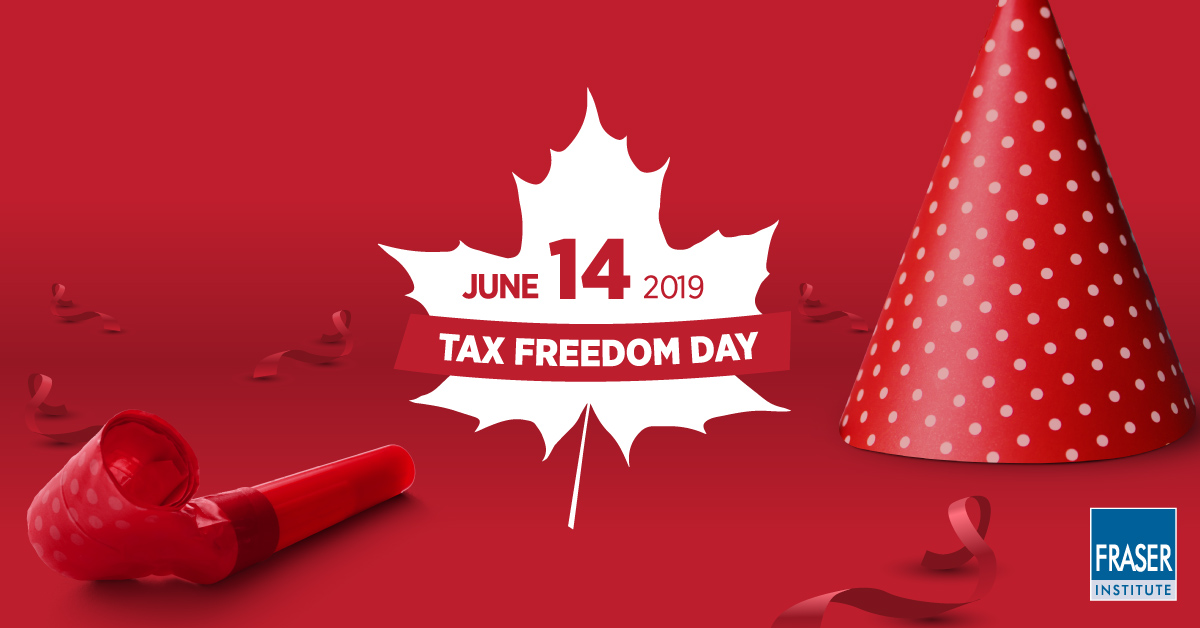June 14 is Tax Freedom Day in Canada—but don’t pop the champagne yet

Have you ever wondered how much you actually pay in taxes each year? While tax returns help us understand how much income tax we pay, it’s difficult for most Canadians to calculate their total tax bill.
In Canada we pay many different taxes to the federal, provincial and local governments. Some of these taxes are visible but many are hidden, which adds to the confusion about how much we actually pay. Not only do we pay income taxes, we also pay property taxes, payroll taxes such as the Canada or Quebec Pension Plans, health taxes, sales taxes such as the GST, carbon taxes, taxes on gasoline, taxes on imported goods, “sin” taxes and so on.
Adding up all these taxes is not easy. But in 2019, we estimate the average Canadian family (consisting of two or more people) will pay $52,675 in total taxes—or 45 per cent of their $117,731 income. In other words, if you paid all your taxes for 2019 up front, you’d give government every dollar you earned before June 14, which we call Tax Freedom Day. After working the first 164 days of the year for governments, you’re finally working for yourself and your family.
But don’t pop the champagne just yet.
Despite these levels of taxation, governments across Canada have not been able to fully fund their spending preferences. In addition to the federal government, three provinces—Ontario, Manitoba and Alberta—are expected to run budget deficits this year. Specifically, the federal government is projecting to spend nearly $20 billion more than it collects in revenue, while the provinces are set to cumulatively spend $16 billion more than their revenue intake.
Of course, future taxpayers will pay for today’s budget deficits—a deficit today is nothing more than a tax deferred to a later date. By kicking today's debt down the road, governments are effectively passing the burden of repayment to young Canadian families. In fact, if Canadian governments raised taxes to balance their budgets instead of financing spending with budget deficits, Tax Freedom Day would arrive eight days later this year, on June 22.
Of course, it’s also important to ask whether we get value for the taxes we pay. Although Canadians can decide this for themselves, providing some perspective here may help.
In education, over the last decade per-student spending on public schools has rapidly increased (by 17.3 per cent) despite a drop in public school enrolment across the country. However, higher levels of education spending have not necessarily delivered better results, as an alarming number of students in Canada are falling short of the standards in mathematics.
And then there’s health care. Although provinces are increasing spending, allocating more than 40 per cent of their budgets to health care, international comparisons demonstrate that Canadians have relatively poor access to medical technology and doctors. Among OECD countries with universal health-care systems, Canada is below average in the number of physicians, acute-care beds and psychiatric beds per person. When measured against other countries with universal care, it’s hard to understand how we’re getting value for our tax dollars.
Understanding your family’s total tax burden is important to assess the value you receive from government services and income transfers. It’s up to Canadians to decide if paying 45 per cent of their income—for average families—is good value given the services actually received.
Authors:
Subscribe to the Fraser Institute
Get the latest news from the Fraser Institute on the latest research studies, news and events.


